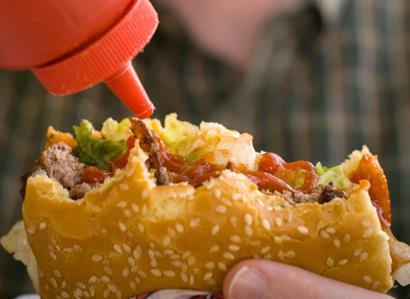Researchers claim to have uncovered the particle dynamics behind 'non-Newtonian' fluids
Researchers in the US claim to have uncovered the single-particle dynamics that leads to so-called non-Newtonian behaviour, which is exhibited in tomato ketchup, paints and many other liquids. The results of the study, which used a combination of confocal microscopy and force measurements, could help in the development of industrial machinery.
For normal, Newtonian fluids, the viscosity stays the same no matter how much shear stress is applied - water is a common example. But non-Newtonian fluids get thinner or thicker with shear stress. Tomato ketchup, for instance, stays almost solid in the bottom of a plastic bottle until it is squeezed, at which point it squirts out easily: it is ’shear thinning’. Meanwhile, a mixture of cornstarch and water turns from being fluid-like to near-solid when shear is applied: it is ’shear thickening’.
One theory for why non-Newtonian behaviour occurs is that particles sometimes move in layers, like cars moving in lanes on a motorway. In shear thinning behaviour, the particles are streamlined in their trajectories, and suffer fewer collisions. In shear thickening behaviour, on the other hand, the layers break up, and there are more collisions. However, techniques used in the past, such as x-ray scattering, have not been sufficient to confirm or refute this idea.

Now, Xiang Cheng, of Cornell University, and colleagues have performed experiments that suggest that the layers idea is incorrect. Using a confocal microscope and a viscosity meter - what they call a ’confocal rheoscope’ - the researchers imaged the flow of silica spheres suspended in water and glycerin as the mixture transitions from shear thinning to Newtonian and, finally, to shear thickening behaviour.
According to Cheng and colleagues, the amount of layering doesn’t change enough for it to be behind non-Newtonian behaviour. Instead, they believe shear thinning happens when shear simply overrides the thermally induced ’Brownian motion’ that would otherwise make particles randomly disperse. Conversely, they say, shear thickening happens when particles are driven past each other too quickly for the fluid to get out of the way. In this situation, the particles lock together, forming clumps that make the fluid more viscous.
Norman Wagner, a chemical engineer at the University of Delaware in Newark, US, says the study by Cheng and colleagues provides the first direct imaging of the clustering theory behind shear thinning, which was formulated over 20 years ago. ’[The researchers’] confocal rheoscope shows promise for enhancing our understanding of the micromechanics of complex fluids by providing real images of model systems under flow,’ he says.
However, chemical engineer John Brady of the California Institute of Technology, US, thinks the researchers have used an oversimplified equation for the relaxation of particles in the suspension - one that could affect their interpretation of the results. Nonetheless, he says: ’The experiments are very nice and contribute to our understanding of colloidal structure and rheology.’
Cheng thinks his group’s results could be important in developing industrial machinery that processes non-Newtonian fluids. ’We have to understand the shear thinning or thickening properties of these fluids to better control the flow rate,’ he says. ’Imagine if a fluid shear thickens - it may suddenly clog [a machine] when the flow rate is increased above certain threshold. This may be a disaster.’
References
X Cheng et al, Science, 2011, 333, 1276 (DOI: 10.1126/science.1207032)






No comments yet